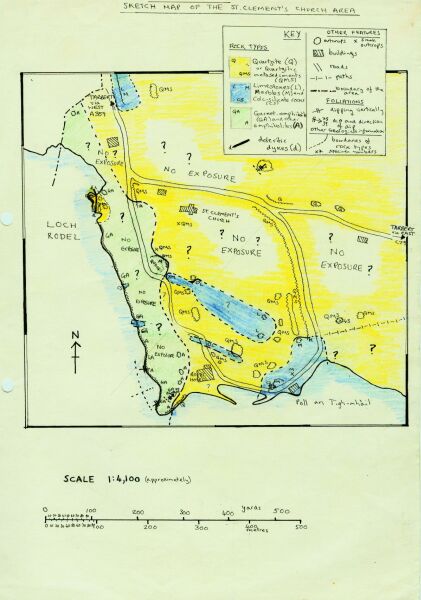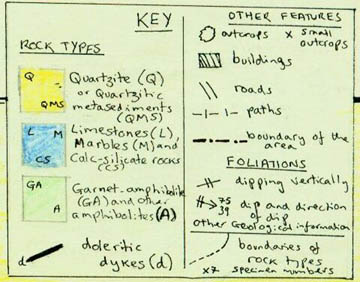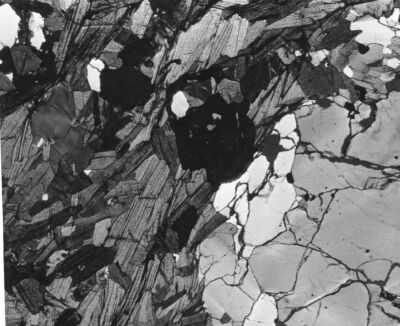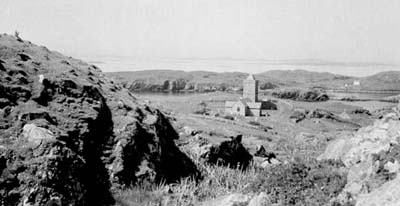

PART II
ROCK UNITS
1. RODEL METASEDIMENTS
Overall nature of the unit
This unit consists of a variety of metamorphic assemblages which can he considered to be metasedimentary in origin.
 | 
|
Sketch map of the Rodel area showing field relationships of the metasediments and other rocks.
These have been divided into the following three groups:
(a) Quartzites
Lithology: These rooks have a bluish, well-banded appearance in hand specimen. They are generally relatively coarse-grained (grain size 3-4mm) and consist predominantly of quartz, with few other minerals present. They abrade into the 'quartzitic metasediments' (discussed below) and thus have not been considered a separate rock unit. The banding is probably due to variations in grain size which were probably an original feature of the sediment (Davidson, 1943, p.83).
Distribution and origin: There is no clear pattern to the exposure of the quartzites, relative to the other rock types of this unit. This is probably due to the original distribution of sedimentary types in the area, though folding; has undoubtedly contributed to the apparently random distribution of the quartzites (see Part III). Since the quartzites are subordinate, in terms of areal extent of exposure, to the 'quartzitic metasediments', they were probably originally thinner than the latter.
(b) Other Quartzitic Metasediments
Lithology: This group consists of a variety of quartz-rich assemblages. In hand specimen they are often deeply weathered and a yellowish or brownish colour in outcrop. The commonest assemblages are garnet - biotite - kyanite - quartz ones, with much variation in relative abundance of these minerals; grain size; and colour. A suggested order of abundance of the minerals present in rocks of this group is: quartz, biotite (sometimes an alteration product of garnet), garnet, kyanite, plagioclase (often sericitized), scapolitised), magnetite-ilmenite, graphite, zircon and calcite.
Microscopic examination of a specimen collected 25 yards WSW of the 361 foot summit of Stuigha showed the rook to consist of 48% biotite, 24% garnet, 21% quartz and 7% plagioclase, scapolite, magnetite-ilmenite, graphite, zircon and calcite (in that order of decreasing abundance).

Plate 1: Photomicrograph of the above specimen
This assemblage is probably not typical of this group, as in hand specimen it is a darker brown colour than the typical rocks of this group. This rock type is coarse-grained (garnet crystals are up to 5mm in diameter, biotites up to 5mm long) and is foliated, this foliation being a tendency for the biotites to be aligned in a similar orientation (see Plate 1). The foliation is probably a result of strain during growth of the biotite.
Often, however, rocks of this group are not foliated, though in many cases the deep weathering may have obscured any foliation present.
One outcrop 200 yards north east of Rodel Hotel consists of a rock of intermediate charnockite composition. In hand specimen it is dark blue and white mottled rock, rather similar to the limestones (see group (c)). The plagioclase is dark blue while the quartz is white. It is generally coarse-grained, though grain size is variable, from 1 - 4mm. Microscopic examination of this rock type showed it to consist of 56% plagioclase (labradorite), 30% quartz, 8% highly pleochroic hypersthene, 4% magnetite-ilmenite, 2% biotite and less than 1% garnet. The plagioclase often shows very thin exsolution lamellae of potash feldspar, but nevertheless the original bulk chemical composition was probably low in potassium.
Original nature and petrogenesis: Rocks of this group were probably originally a series of pelites and psammites (from mineral composition) in alternating thin bands (explaining the non-persistence of rock types over even small areas). These were metamorphosed in the granulite facies and later some retrograding occurred with scapolitization of plagioclase suggesting permeation by volatiles, probably associated with the granite-migmatite complex to the north of this area (Kursten 1957).
The "charnockite" described above may represent local metamorphism of a higher grade then elsewhere, or it may be the result of metamorphism of a small intrusion or volcanic rock more or less contemporaneous with the sediment. It is possible that it represents the original basement to the sedimentation.
(c) Limestones, Marbles and Calc-Silicate rocks
Lithology:
(i) Limestones: In hand specimen these are generally black and white mottled rocks, with black forsterite crystals (l - 2mm) in a matrix of white carbonate (calcite or dolomite). Other minerals present include diopside, pargasite, spinel, phlogopite, apatite, graphite, pyrrhotite and zircon (Davidson 1943).
(ii) Marbles: The marbles are probably of similar composition to the limestones, except that forsterite is not so prominent and the colour is generally yellowish.
(iii) Calc-silicate rooks: In hand specimen these are greyish rocks with patches of mica, calcite and pyrrhotite. A thin section of such a rock, collected 5 yards east of the gate at Rodel pier, showed it to consist of 72% diopside, 13% pargasite and 8% calcite with minor quartz, phlogopite, zircon, graphite and pyrrhotite. The phlogopite is usually associated with the pargasite, which is pleochroic X pale yellow Y and Z yellowish brown. [Davidson (1943, p.78) also notes the occurrence of forsterite (rarely), scapolite, plagioclase, clinozoisite, apatite and zircon in the calc-silicate rocks.] This specimen had variable grain size, with phlogopite occurring in patches of plates up to 1 cm square. Diopside grains are generally 1 - 2 mm long.
Distribution: These rock types occur in close association, generally in lenticular exposures, with limestone forming the bulk of a lens and calc-silicate rocks generally occurring on the margins. Davidson (1943, p.72) considers that the limestones (and associated rocks) have 'behaved, under pressure as much more plastic material than the associated paragneiss', to give the lenticular exposures.
Original nature and petrogenesis: Davidson (1943, p.77) considers that the limestones represent thin bands 'intercalated with arenaceous and argillaceous strata' which hypothesis is compatible with the discontinuous nature of the lenses. Metamorphism of these rocks was undoubtedly of the granulite facies, with the formation of forsterite and diopside in the limestones and calc-silicate rocks respectively. There is little evidence of any retrograding or metasomatism of these rocks, though Davidson (1943) has observed scapolitization of plagioclases in the calc-silicate rocks.

St Clements Church from Stuigha
Age of the unit: Since the metamorphism of these rocks has been correlated to the Scourian metamorphism of the mainland of Scotland (Dearnley 1962) the sediments must have been deposited in pre-Scourian times. Recent evidence suggests that these metasediments are between 3000 and 2600 million years old. (Coward et al 1969).